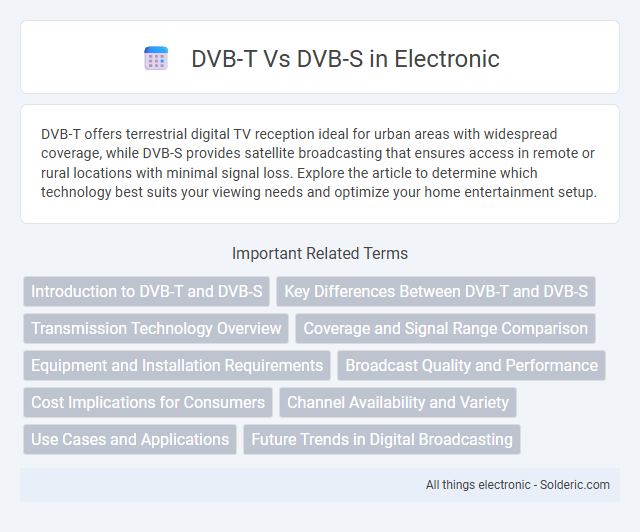DVB-T offers terrestrial digital TV reception ideal for urban areas with widespread coverage, while DVB-S provides satellite broadcasting that ensures access in remote or rural locations with minimal signal loss. Explore the article to determine which technology best suits your viewing needs and optimize your home entertainment setup.
Comparison Table
| Feature | DVB-T (Digital Video Broadcasting - Terrestrial) | DVB-S (Digital Video Broadcasting - Satellite) |
|---|---|---|
| Transmission Medium | Terrestrial (over-the-air, ground-based transmitters) | Satellite (via geostationary satellites) |
| Coverage Area | Localized, region-specific coverage | Wide-area, often continental or national coverage |
| Signal Frequency | VHF/UHF bands (typically 174-230 MHz & 470-862 MHz) | Ku-band (12-18 GHz) or C-band (4-8 GHz) |
| Receiver Equipment | Terrestrial antenna + DVB-T tuner | Satellite dish + DVB-S tuner |
| Signal Quality | Susceptible to obstacles and interference | Generally stable, affected by weather conditions |
| Bandwidth | Limited by terrestrial spectrum allocation | Higher bandwidth available for channels and data |
| Use Cases | Local TV broadcasting, urban areas | National/satellite TV, remote and rural areas |
| Cost | Lower setup costs (antenna & receiver) | Higher setup cost (satellite dish installation) |
| Interactivity | Limited, mainly one-way broadcast | Supports interactive services with return channels |
Introduction to DVB-T and DVB-S
DVB-T (Digital Video Broadcasting - Terrestrial) transmits digital television signals over terrestrial radio frequencies, enabling free-to-air TV reception using an antenna. DVB-S (Digital Video Broadcasting - Satellite) delivers digital broadcasts via geostationary satellites, providing extensive coverage and access to a wide range of channels, including international content. Both standards utilize MPEG-2 or MPEG-4 compression but differ fundamentally in their transmission methods and reception equipment requirements.
Key Differences Between DVB-T and DVB-S
DVB-T (Digital Video Broadcasting - Terrestrial) transmits digital TV signals over terrestrial airwaves using VHF or UHF frequencies, ideal for urban and regional coverage, while DVB-S (Digital Video Broadcasting - Satellite) delivers signals via geostationary satellites, providing broader geographic reach, including remote areas. DVB-T typically supports multiple channels in a single frequency band through multiplexing, whereas DVB-S offers higher bandwidth capacity and better signal quality suited for high-definition broadcasts. Understanding these key differences helps you choose the appropriate system based on coverage needs, signal quality, and infrastructure availability.
Transmission Technology Overview
DVB-T uses terrestrial transmission, broadcasting digital television signals over radio frequencies via ground-based transmitters, ideal for urban and suburban coverage. DVB-S relies on satellite transmission, sending signals from satellites orbiting the Earth directly to your satellite dish, enabling widespread coverage including remote areas. Your choice depends on your location and reception needs, with DVB-T suited for local areas and DVB-S for broader geographic reach.
Coverage and Signal Range Comparison
DVB-T offers robust coverage ideal for urban and suburban areas with a typical range of up to 60 kilometers, utilizing terrestrial transmitters. DVB-S provides extensive signal range through satellite transmission, covering vast geographical regions, including remote and rural areas, with footprints extending over thousands of kilometers. Your choice between DVB-T and DVB-S depends on the required coverage area and signal reach, balancing local accessibility versus wide-area satellite availability.
Equipment and Installation Requirements
DVB-T requires a terrestrial antenna and a compatible receiver, often easier and less expensive to install due to the widespread availability of over-the-air signals. DVB-S necessitates a satellite dish, a precise alignment procedure, and a satellite receiver or set-top box, resulting in higher initial setup costs and more complex installation. Equipment for DVB-S is generally bulkier and less portable compared to the more compact and straightforward tools used for DVB-T.
Broadcast Quality and Performance
DVB-T delivers robust broadcast quality for terrestrial transmission, optimized for urban and rural reception with resistance to multipath interference and signal fading, ensuring stable performance in mobile environments. DVB-S provides superior quality for satellite broadcasts, offering higher data rates and wider coverage, ideal for HD and UHD content with minimal compression artifacts. Your choice depends on the required broadcast range and content resolution, with DVB-S excelling in high-quality satellite delivery and DVB-T benefiting terrestrial accessibility.
Cost Implications for Consumers
DVB-T receivers typically have lower upfront costs compared to DVB-S receivers due to simpler antenna requirements and terrestrial infrastructure. However, DVB-S services may involve higher subscription fees for satellite channels and potential costs for dish installation. Consumers opting for DVB-T benefit from reduced ongoing expenses, whereas DVB-S offers a broader range of premium content at increased overall expenditure.
Channel Availability and Variety
DVB-T provides access to a wide range of local and regional channels, making it ideal for terrestrial broadcast coverage with diverse programming options. DVB-S offers a broader selection of channels, including international and specialty content, due to satellite's extensive footprint and higher capacity. The greater channel variety on DVB-S supports niche genres and premium services not typically available via DVB-T.
Use Cases and Applications
DVB-T is primarily used for terrestrial television broadcasting, ideal for urban and rural areas with established ground infrastructure, making it suitable for local and regional TV services. DVB-S supports satellite broadcasting, providing extensive coverage including remote and underserved regions, which is crucial for nationwide or international broadcasting and satellite internet services. Your choice between DVB-T and DVB-S depends on whether you require localized terrestrial reception or broad satellite transmission capabilities.
Future Trends in Digital Broadcasting
DVB-T and DVB-S remain crucial technologies in digital broadcasting, with DVB-T primarily supporting terrestrial transmissions and DVB-S dominating satellite broadcasting. Future trends indicate a shift towards DVB-T2 and DVB-S2 standards, offering enhanced spectral efficiency, higher data rates, and better error correction, which improve broadcast quality and robustness. Your decision to adopt these technologies should consider emerging hybrid solutions that integrate both terrestrial and satellite systems for seamless coverage and content delivery.
DVB-T vs DVB-S Infographic

 solderic.com
solderic.com